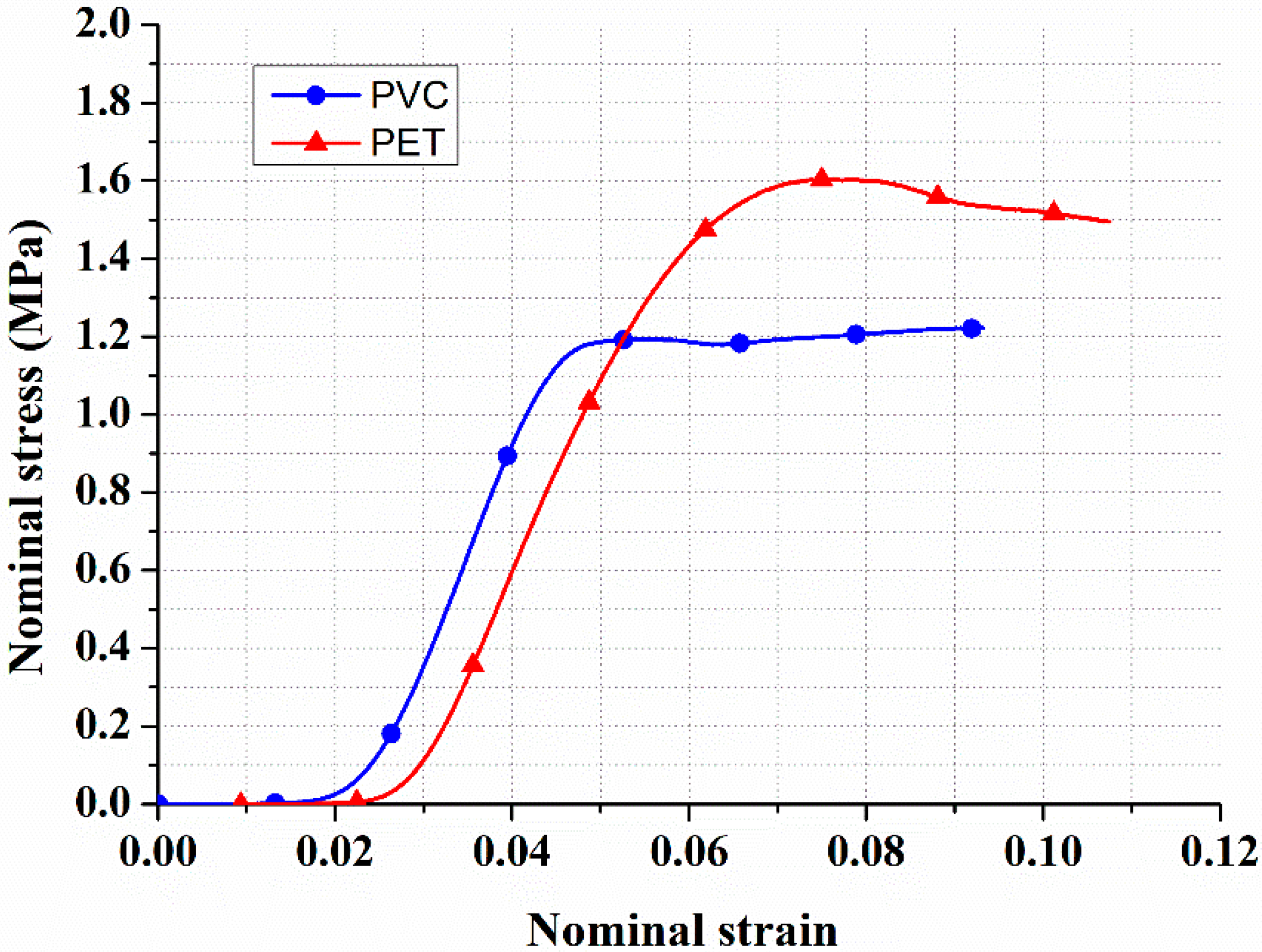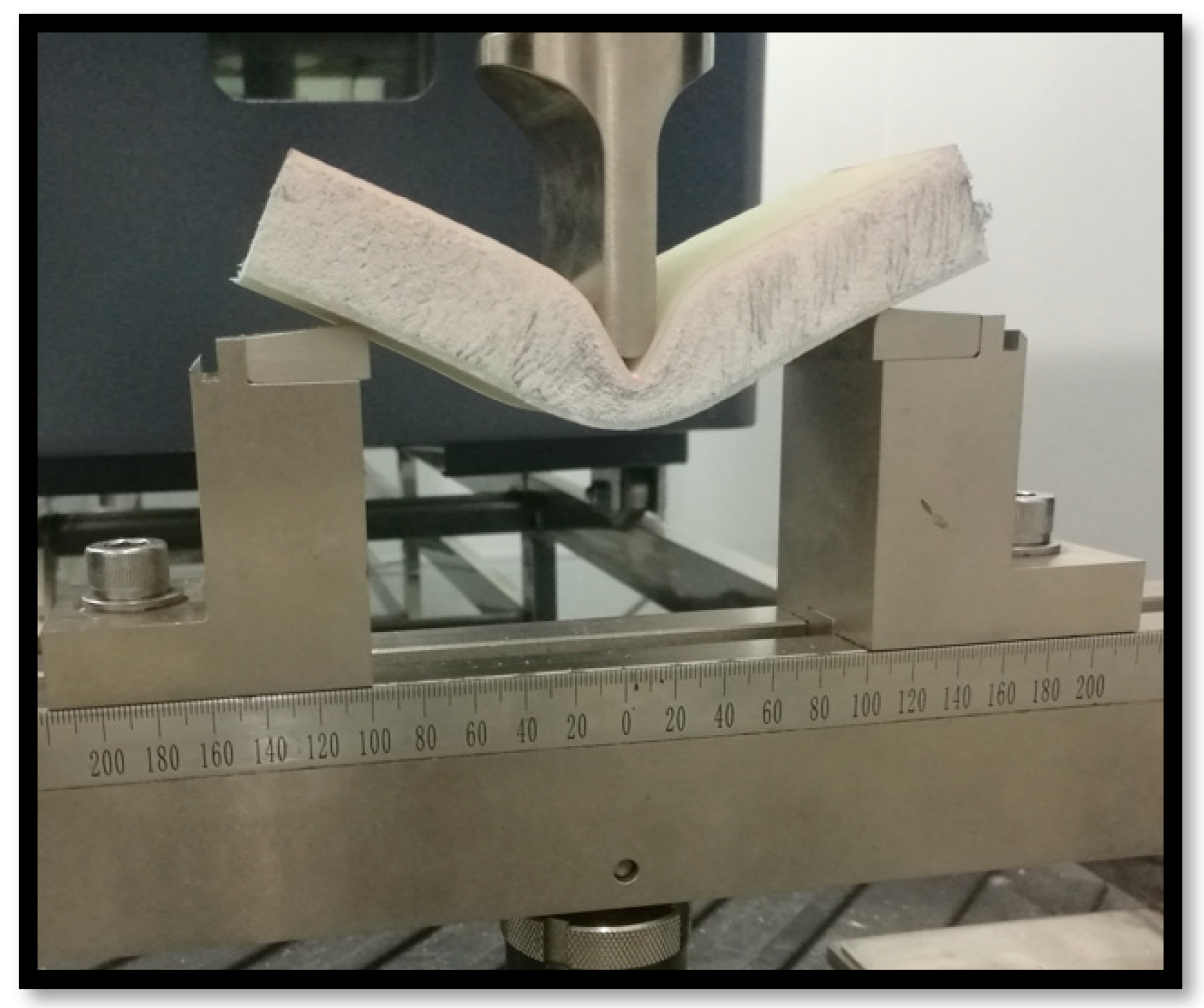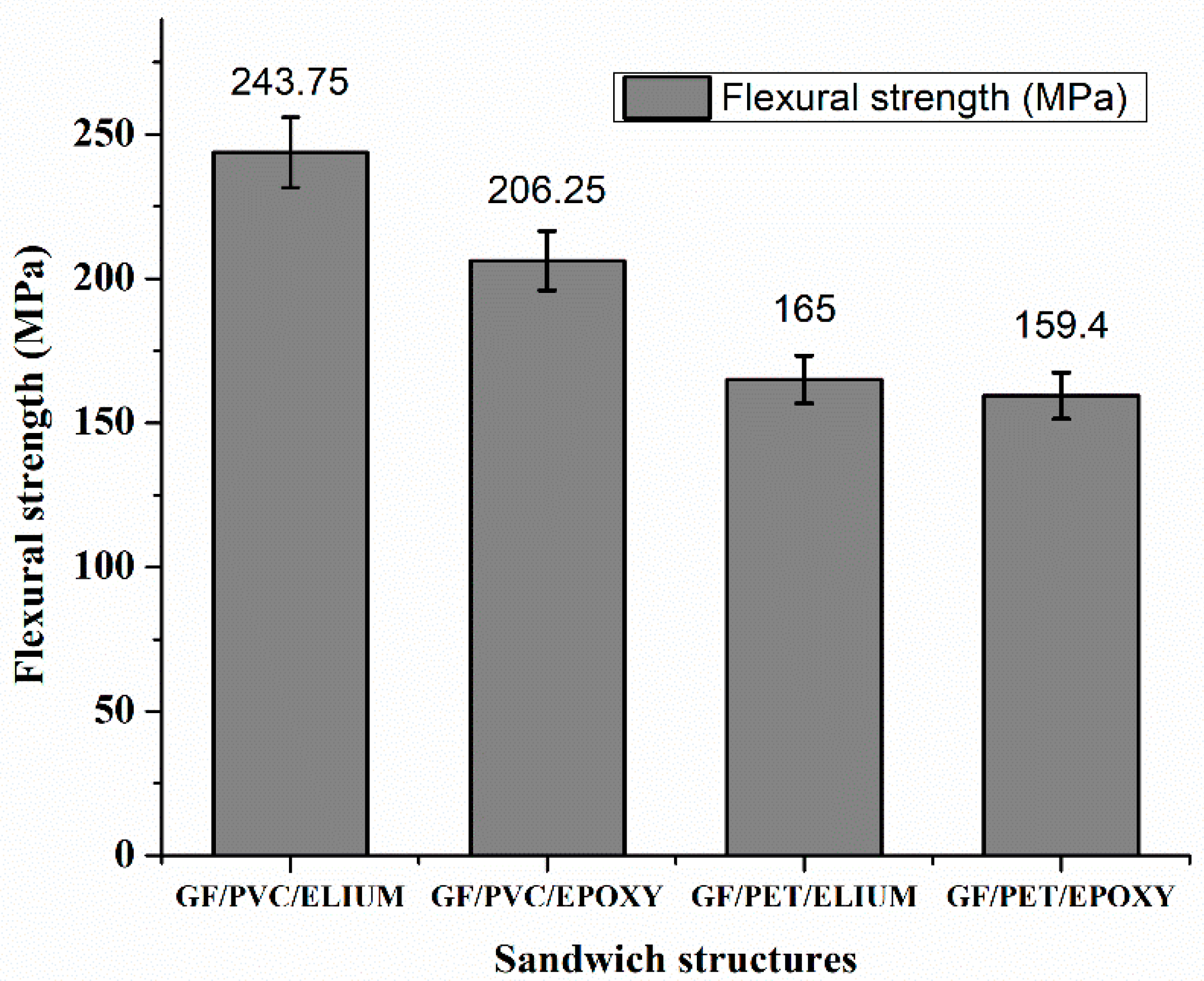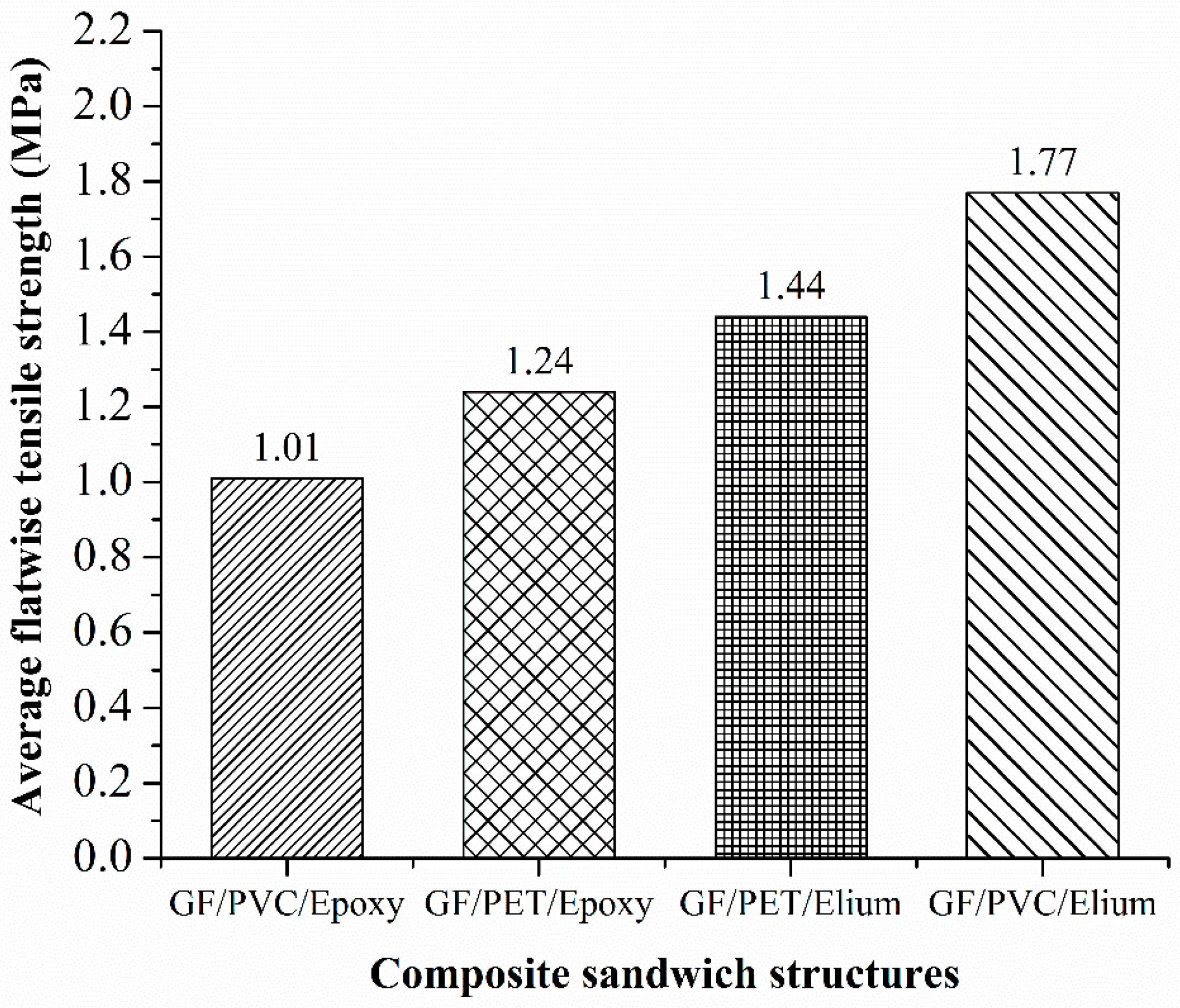RETRACTED: Mechanical Properties Study on Sandwich Composites of Glass Fiber Reinforced Plastics (GFRP) Using Liquid Thermoplastic Resin, Elium®: Preliminary Experiments
Abstract
:1. Introduction
2. Materials and Methods
2.1. Materials
2.1.1. Skin Material
2.1.2. Core Materials
2.1.3. Liquid Thermoplastic Resin
3. Sandwich Composites Fabrication
4. Experimental Test Setup and Procedure
4.1. Sandwich Composite Flexural Tests
4.2. Sandwich Composites Climbing Drum Peel
4.3. Sandwich Composites Flatwise-Tensile Strength
5. Results and Discussion
5.1. Sandwich Composite Three-Point Bending
5.2. Sandwich Composites Climbing Drum Peel
5.3. Sandwich Composites Flatwise Tensile Strength
6. Conclusions
Author Contributions
Funding
Institutional Review Board Statement
Informed Consent Statement
Data Availability Statement
Acknowledgments
Conflicts of Interest
References
- Kessler, M.R. Polymer matrix composites: A perspective for a special issue of polymer reviews. Polym. Rev. 2012, 52, 229–233. [Google Scholar] [CrossRef]
- Patlolla, V.; Asmatulu, R. Recycling and reusing fiber-reinforced composites. Environ. Res. J. 2013, 7, 145–160. [Google Scholar]
- Krauklis, A.E.; Karl, C.W.; Gagani, A.I.; Jørgensen, J.K. Composite material recycling technology—State-of-the-art and sustainable development for the 2020s. J. Compos. Sci. 2021, 5, 28. [Google Scholar] [CrossRef]
- Eker, A.A.; Eker, B. General Assessment of Fiber-Reinforced Composites Selection in Wind Turbine Blades; Mechanical Engineering Department, Yıldız Technical University: İstanbul, Turkey, 2013; Volume 20. [Google Scholar]
- Jayalakshmi, C.; Anand, A.; Kandasubramanian, B.; Joshi, M. High temperature composite materials for electromagnetic applications through a cost effective manufacturing process; resin film infusion. Mater. Today Proc. 2020, 33, 2217–2222. [Google Scholar] [CrossRef]
- Ma, Q.; Rejab, M.; Siregar, J.; Guan, Z. A review of the recent trends on core structures and impact response of sandwich panels. J. Compos. Mater. 2021, 55, 2513–2555. [Google Scholar] [CrossRef]
- Leong, M.; Overgaard, L.C.; Thomsen, O.T.; Lund, E.; Daniel, I.M. Investigation of failure mechanisms in GFRP sandwich structures with face sheet wrinkle defects used for wind turbine blades. Compos. Struct. 2012, 94, 768–778. [Google Scholar] [CrossRef]
- Khalid, S.A.; Khan, A.M.; Shah, O.R. A Numerical Study Into the Use of Auxectic Structures for Structural Damping in Composite Sandwich Core Panels for Wind Turbine Blades. J. Energy Resour. Technol. 2022, 144, 031301. [Google Scholar] [CrossRef]
- Vieira, P.R.; Carvalho, E.M.L.; Vieira, J.D.; Toledo Filho, R.D. Experimental fatigue behavior of pultruded glass fibre reinforced polymer composite materials. Compos. Part B Eng. 2018, 146, 69–75. [Google Scholar] [CrossRef]
- Yazdanbakhsh, A.; Bank, L.C. A critical review of research on reuse of mechanically recycled FRP production and end-of-life waste for construction. Polymers 2014, 6, 1810–1826. [Google Scholar] [CrossRef]
- Bagherpour, S. Fibre Reinforced Polyester Composites; InTech: London, UK, 2012. [Google Scholar]
- Chen, Y. Glass Fiber-Reinforced Polymer Composites for Power Equipment. In Polymer Composites for Electrical Engineering; John Wiley & Sons, Inc.: Hoboken, NJ, USA, 2021; pp. 377–417. [Google Scholar] [CrossRef]
- Qian, D.; Bao, L.; Takatera, M.; Kemmochi, K.; Yamanaka, A. Fiber-reinforced polymer composite materials with high specific strength and excellent solid particle erosion resistance. Wear 2010, 268, 637–642. [Google Scholar] [CrossRef]
- Sen, R.; Mullins, G. Application of FRP composites for underwater piles repair. Compos. Part B Eng. 2007, 38, 751–758. [Google Scholar] [CrossRef]
- Bhagwat, P.; Ramachandran, M.; Raichurkar, P. Mechanical properties of hybrid glass/carbon fiber reinforced epoxy composites. Mater. Today Proc. 2017, 4, 7375–7380. [Google Scholar] [CrossRef]
- Frketic, J.; Dickens, T.; Ramakrishnan, S. Automated manufacturing and processing of fiber-reinforced polymer (FRP) composites: An additive review of contemporary and modern techniques for advanced materials manufacturing. Addit. Manuf. 2017, 14, 69–86. [Google Scholar] [CrossRef]
- Goh, G.D.; Yap, Y.L.; Agarwala, S.; Yeong, W.Y. Recent progress in additive manufacturing of fiber reinforced polymer composite. Adv. Mater. Technol. 2019, 4, 1800271. [Google Scholar] [CrossRef]
- Alampalli, S.; O’Connor, J.; Yannotti, A.P. Design, Fabrication, Construction, and Testing of an FRP Superstructure; Transportation Research and Development Bureau, New York State Department of Transportation: Albany, NY, USA, 2000; Volume 134.
- Hennigan, D.J.; Beavers, K.D. Effect of fabrication processes on mechanical properties of glass fiber reinforced polymer composites for 49 meter (160 foot) recreational yachts. Int. J. Nav. Archit. Ocean. Eng. 2010, 2, 45–56. [Google Scholar]
- Ngo, T.-D. Introduction to composite materials. In Composite and Nanocomposite Materials—From Knowledge to Industrial Applications; Intechopen: London, UK, 2020. [Google Scholar]
- Olabi, A.G.; Wilberforce, T.; Elsaid, K.; Sayed, E.T.; Salameh, T.; Abdelkareem, M.A.; Baroutaji, A. A review on failure modes of wind turbine components. Energies 2021, 14, 5241. [Google Scholar] [CrossRef]
- Redlinger, R.; Andersen, P.; Morthorst, P. Wind Energy in the 21st Century: Economics, Policy, Technology and the Changing Electricity Industry; Springer: Berlin/Heidelberg, Germany, 2016. [Google Scholar]
- Fatima, N.S.; Dhaliwal, G.S.; Newaz, G. Influence of interfacial adhesive on impact and post-impact behaviors of CFRP/end-grain balsawood sandwich composites. Compos. Part B Eng. 2021, 212, 108718. [Google Scholar] [CrossRef]
- Khan, T.; Aziz, A.R.; Irfan, M.S.; Cantwell, W.J.; Umer, R. Energy absorption in carbon fiber honeycomb structures manufactured using a liquid thermoplastic resin. J. Compos. Mater. 2022, 56, 1335–1348. [Google Scholar] [CrossRef]
- Bhudolia, S.K.; Gohel, G.; Leong, K.F.; Joshi, S.C. Damping, impact and flexural performance of novel carbon/Elium® thermoplastic tubular composites. Compos. Part B Eng. 2020, 203, 108480. [Google Scholar] [CrossRef]
- Bhudolia, S.K.; Perrotey, P.; Joshi, S.C. Mode I fracture toughness and fractographic investigation of carbon fibre composites with liquid Methylmethacrylate thermoplastic matrix. Compos. Part B Eng. 2018, 134, 246–253. [Google Scholar] [CrossRef]
- Durai Prabhakaran, R. Are reactive thermoplastic polymers suitable for future wind turbine composite materials blades? Mech. Adv. Mater. Struct. 2014, 21, 213–221. [Google Scholar] [CrossRef]
- Kinvi-Dossou, G.; Boumbimba, R.M.; Bonfoh, N.; Koutsawa, Y.; Eccli, D.; Gerard, P. A numerical homogenization of E-glass/acrylic woven composite laminates: Application to low velocity impact. Compos. Struct. 2018, 200, 540–554. [Google Scholar] [CrossRef]
- Bhudolia, S.K.; Perrotey, P.; Joshi, S.C. Optimizing polymer infusion process for thin ply textile composites with novel matrix system. Materials 2017, 10, 293. [Google Scholar] [CrossRef]
- Cheewaket, T.; Jaturapitakkul, C.; Chalee, W. Initial corrosion presented by chloride threshold penetration of concrete up to 10 year-results under marine site. Constr. Build. Mater. 2012, 37, 693–698. [Google Scholar] [CrossRef]
- Torres-Acosta, A.A.; Mart ínez-Madrid, M. Residual life of corroding reinforced concrete structures in marine environment. J. Mater. Civ. Eng. 2003, 15, 344–353. [Google Scholar] [CrossRef]
- Thakre, P.R.; Singh, R.; Slipher, G. Mechanics of Composite and Multi-Functional Materials; Springer: Berlin/Heidelberg, Germany, 2018; Volume 6. [Google Scholar]
- Obande, W.; Brádaigh, C.M.Ó.; Ray, D. Continuous fibre-reinforced thermoplastic acrylic-matrix composites prepared by liquid resin infusion—A review. Compos. Part B Eng. 2021, 215, 108771. [Google Scholar] [CrossRef]
- Grünewald, J.; Parlevliet, P.P.; Matschinski, A.; Altstädt, V. Mechanical performance of CF/PEEK–PEI foam core sandwich structures. J. Sandw. Struct. Mater. 2019, 21, 2680–2699. [Google Scholar] [CrossRef]
- Valenza, A.; Fiore, V.; Calabrese, L. Three-point flexural behaviour of GFRP sandwich composites: A failure map. Adv. Compos. Mater. 2010, 19, 79–90. [Google Scholar] [CrossRef]
- Borsellino, C.; Calabrese, L.; Valenza, A. Experimental and numerical evaluation of sandwich composite structures. Compos. Sci. Technol. 2004, 64, 1709–1715. [Google Scholar] [CrossRef]
- Zhang, F.; Mohmmed, R.; Sun, B.; Gu, B. Damage Behaviors of Foam Sandwiched Composite Materials Under Quasi-Static Three-point Bending. Appl. Compos. Mater. 2013, 20, 1231–1246. [Google Scholar] [CrossRef]
- Xiao, Y.; Hu, Y.; Zhang, J.; Song, C.; Huang, X.; Yu, J.; Liu, Z. The bending responses of sandwich panels with aluminium honeycomb core and CFRP skins used in electric vehicle body. Adv. Mater. Sci. Eng. 2018, 2018, 5750607. [Google Scholar] [CrossRef]
- Mostafa, A.; Shankar, K.; Morozov, E. Behaviour of PU-foam/glass-fibre composite sandwich panels under flexural static load. Mater. Struct. 2015, 48, 1545–1559. [Google Scholar] [CrossRef]
- Russell, B.; Liu, T.; Fleck, N.; Deshpande, V. Quasi-static three-point bending of carbon fiber sandwich beams with square honeycomb cores. J. Appl. Mech. 2011, 78, 031008. [Google Scholar] [CrossRef]
- Sun, Y.; Guo, L.-C.; Wang, T.-S.; Zhong, S.-Y.; Pan, H.-Z. Bending behavior of composite sandwich structures with graded corrugated truss cores. Compos. Struct. 2018, 185, 446–454. [Google Scholar] [CrossRef]
- Wang, B.; Shi, Y.; Zhou, C.; Li, T. Failure mechanism of PMI foam core sandwich beam in bending. Int. J. Simul. Multidiscip. Des. Optim. 2015, 6, A8. [Google Scholar] [CrossRef]
- Wang, N.-Z.; Xiang, C.; Ao, L.; Li, Y.-X.; Zhang, H.-W.; Yuan, L. Three-point bending performance of a new aluminum foam composite structure. Trans. Nonferrous Met. Soc. China 2016, 26, 359–368. [Google Scholar] [CrossRef]
- Zhang, J.; Supernak, P.; Mueller-Alander, S.; Wang, C.H. Improving the bending strength and energy absorption of corrugated sandwich composite structure. Mater. Des. 2013, 52, 767–773. [Google Scholar] [CrossRef]
- Krzyżak, A.; Mazur, M.; Gajewski, M.; Drozd, K.; Komorek, A.; Przybyłek, P. Sandwich structured composites for aeronautics: Methods of manufacturing affecting some mechanical properties. Int. J. Aerosp. Eng. 2016, 2016, 7816912. [Google Scholar] [CrossRef]
- Champliaud, H.; Feng, Z.; Bersee, H. Three-point bending testing of sandwich beams and finite element comparison. In Proceedings of the ASME 2009 International Mechanical Engineering Congress and Exposition, Lake Buena Vista, FL, USA, 13–19 November 2009; pp. 357–363. [Google Scholar]
- Mostafa, A.; Shankar, K.; Morozov, E. Experimental, theoretical and numerical investigation of the flexural behaviour of the composite sandwich panels with PVC foam core. Appl. Compos. Mater. 2014, 21, 661–675. [Google Scholar] [CrossRef]
- Carrera, E.; Pagani, A.; Valvano, S. Shell elements with through-the-thickness variable kinematics for the analysis of laminated composite and sandwich structures. Compos. Part B Eng. 2017, 111, 294–314. [Google Scholar] [CrossRef]
- Nunes, J.; Silva, J. Sandwiched composites in aerospace engineering. In Advanced Composite Materials for Aerospace Engineering; Elsevier: Amsterdam, The Netherlands, 2016; pp. 129–174. [Google Scholar]
- Riccio, A.; Raimondo, A.; Sellitto, A.; Acanfora, V.; Zarrelli, M. Multifunctional Polypropylene Core for Aerospace Sandwich Composite Panels. Procedia Eng. 2016, 167, 64–70. [Google Scholar] [CrossRef]
- Ahmed, A.; Wei, L. Introducing CFRP as an alternative material for engine hood to achieve better pedestrian safety using finite element modeling. Thin-Walled Struct. 2016, 99, 97–108. [Google Scholar] [CrossRef]
- Ahmed, A.; Bingjie, Z.; Ikbal, M.H.; Qingtao, W.; Obed, A.; Wei, L. Experimental study on the effects of stacking sequence on low velocity impact and quasi-static response of foam sandwich composite structures. Adv. Struct. Eng. 2015, 18, 1789–1805. [Google Scholar] [CrossRef]
- Khan, M.; Syed, A.; Ijaz, H.; Shah, R. Experimental and numerical analysis of flexural and impact behaviour of glass/pp sandwich panel for automotive structural applications. Adv. Compos. Mater. 2018, 27, 367–386. [Google Scholar] [CrossRef]
- Chen, Y.; Das, R. A review on manufacture of polymeric foam cores for sandwich structures of complex shape in automotive applications. J. Sandw. Struct. Mater. 2022, 24, 789–819. [Google Scholar] [CrossRef]
- Cousins, D.S.; Suzuki, Y.; Murray, R.E.; Samaniuk, J.R.; Stebner, A.P. Recycling glass fiber thermoplastic composites from wind turbine blades. J. Clean. Prod. 2019, 209, 1252–1263. [Google Scholar] [CrossRef]
- Frej, H.B.H.; Léger, R.; Perrin, D.; Ienny, P.; Gérard, P.; Devaux, J.-F. Recovery and reuse of carbon fibre and acrylic resin from thermoplastic composites used in marine application. Resour. Conserv. Recycl. 2021, 173, 105705. [Google Scholar] [CrossRef]
- Subadra, S.P.; Griskevicius, P. Sustainability of polymer composites and its critical role in revolutionising wind power for green future. Sustain. Technol. Green Econ. 2021, 1, 1–7. [Google Scholar] [CrossRef]
- Dorigato, A. Recycling of thermosetting composites for wind blade application. Adv. Ind. Eng. Polym. Res. 2021, 4, 116–132. [Google Scholar] [CrossRef]
- Characteristic of Wind Turbine Blades. Available online: https://www.windfarmbop.com/characteristics-of-wind-turbine-blades/ (accessed on 28 June 2022).
- Zhu, D.; Zhang, X.; Zhang, H. Effects of strain rate and temperature on mechanical properties of Kevlar 49 aramid fabric reinforced epoxy polymers under dynamic tensile loading. Acta Mater. Compos. Sin. 2016, 33, 459–468. [Google Scholar]
- Xia, Y.; Zhu, J.; Zhou, Q. Verification of a multiple-machine program for material testing from quasi-static to high strain-rate. Int. J. Impact Eng. 2015, 86, 284–294. [Google Scholar] [CrossRef]
- Huh, H.; Ahn, K.; Lim, J.H.; Kim, H.W.; Park, L.J. Evaluation of dynamic hardening models for BCC, FCC, and HCP metals at a wide range of strain rates. J. Mater. Process. Technol. 2014, 214, 1326–1340. [Google Scholar] [CrossRef]
- Zhu, J.; Xia, Y.; Gu, G.; Zhou, Q. Extension of non-associated Hill48 Model for characterizing dynamic mechanical behavior of a typical high-strength steel sheet. In Proceedings of the ASME International Mechanical Engineering Congress and Exposition, Montreal, QC, Canada, 14–20 November 2014; p. V009T012A097. [Google Scholar]
- Cousins, D.S. Advanced Thermoplastic Composites for Wind Turbine Blade Manufacturing; Colorado School of Mines: Golden, CO, USA, 2018. [Google Scholar]
- Davies, P.; Arhant, M. Fatigue behaviour of acrylic matrix composites: Influence of seawater. Appl. Compos. Mater. 2019, 26, 507–518. [Google Scholar] [CrossRef]
- Wang, X.; Lu, H.; Gorbacheva, G.; Hossain, M.; Fu, Y.Q. Multi-modal commutative dynamics in semi-crystalline polymers undergoing multiple shape memory behavior. Smart Mater. Struct. 2021, 30, 045003. [Google Scholar] [CrossRef]
- Wang, N.; Raza, A.; Si, Y.; Yu, J.; Sun, G.; Ding, B. Tortuously structured polyvinyl chloride/polyurethane fibrous membranes for high-efficiency fine particulate filtration. J. Colloid Interface Sci. 2013, 398, 240–246. [Google Scholar] [CrossRef] [PubMed]
- Zhang, P.; Cheng, Y.; Liu, J.; Li, Y.; Zhang, C.; Hou, H.; Wang, C. Experimental study on the dynamic response of foam-filled corrugated core sandwich panels subjected to air blast loading. Compos. Part B Eng. 2016, 105, 67–81. [Google Scholar] [CrossRef]
- Park, S.; Thanakkasaranee, S.; Shin, H.; Lee, Y.; Tak, G.; Seo, J. Pet/bio-based terpolyester blends with high dimensional thermal stability. Polymers 2021, 13, 728. [Google Scholar] [CrossRef]
- Albanese, M.; Boyenval, J.; Marchese, P.; Sullalti, S.; Celli, A. The aliphatic counterpart of PET, PPT and PBT aromatic polyesters: Effect of the molecular structure on thermo-mechanical properties. AIMS Mol. Sci. 2016, 3, 32–51. [Google Scholar]
- Wu, Y.; Xing, Y.; Liu, B. Analysis of isotropic and composite laminated plates and shells using a differential quadrature hierarchical finite element method. Compos. Struct. 2018, 205, 11–25. [Google Scholar] [CrossRef]
- Yan, Y.; Liu, B.; Xing, Y.; Carrera, E.; Pagani, A. Free vibration analysis of variable stiffness composite laminated beams and plates by novel hierarchical differential quadrature finite elements. Compos. Struct. 2021, 274, 114364. [Google Scholar] [CrossRef]
- Kabir, H.; Aghdam, M. A robust Bézier based solution for nonlinear vibration and post-buckling of random checkerboard graphene nano-platelets reinforced composite beams. Compos. Struct. 2019, 212, 184–198. [Google Scholar] [CrossRef]
- Kabir, H.; Aghdam, M.M. A generalized 2D Bézier-based solution for stress analysis of notched epoxy resin plates reinforced with graphene nanoplatelets. Thin-Walled Struct. 2021, 169, 108484. [Google Scholar] [CrossRef]
- Gower, M.; Sims, G. Determining the Skin-to-Core Bond Strength of Sandwich Constructions; NPL Report; NPL: Teddington, UK, 1999. [Google Scholar]










| Property | PVC | PET |
|---|---|---|
| Value | Value | |
| Density (kg/m3) | 60 | 75 |
| Elastic modulus (MPa) | 100 | 89 |
| Shear modulus (MPa) | 21 | 13 |
| Tensile strength (MPa) | 1.82 | 1.49 |
| Compressive strength (MPa) | 0.98 | 0.96 |
| Shear strength (MPa) | 0.79 | 0.53 |
| Elongation at break (%) | 18 | 44 |
| Property | Epoxy 2040 | Elium® 188 |
|---|---|---|
| Value | Value | |
| Density (kg/m3) | 1.16 | 1.18 |
| Tensile strength (MPa) | 45–85 | 55–76 |
| Tensile modulus (MPa) | 2800–3400 | 3100–3300 |
| Flexural modulus (MPa) | 2600–3600 | 3250 |
| Flexural strength (MPa) | 100–130 | 130 |
| Elongation at break (%) | 1.3–5.0 | 4–6 |
| Sandwich Structure | Load (N) | Flexural Strength (MPa) | Flexural Modulus (GPa) |
|---|---|---|---|
| GF/PVC/ELIUM | 1308 | 243.75 | 0.26 |
| GF/PVC/EPOXY | 1156 | 206.25 | 0.215 |
| GF/PET/ELIUM | 868 | 165 | 0.18 |
| GF/PET/EPOXY | 845 | 159.4 | 0.16 |
| Sandwich Structures | Sample No. | Force (KN) | Strength (MPa) |
|---|---|---|---|
| GF/PVC/Epoxy | 1 | 0.746 | 1.1936 |
| 2 | 0.595 | 0.952 | |
| 3 | 0.804 | 1.2864 | |
| 4 | 0.595 | 0.952 | |
| 5 | 0.697 | 1.1152 | |
| Average | 0.69 | 1.01 | |
| SD | 0.075 | 0.12 | |
| GF/PET/Epoxy | 1 | 0.626 | 1.0016 |
| 2 | 0.668 | 1.0688 | |
| 3 | 0.836 | 1.3376 | |
| 4 | 0.863 | 1.3808 | |
| 5 | 0.869 | 1.3904 | |
| Average | 0.77 | 1.24 | |
| SD | 0.095 | 0.15 | |
| GF/PET/Elium | 1 | 0.826 | 1.3216 |
| 2 | 0.661 | 1.0576 | |
| 3 | 1.036 | 1.6576 | |
| 4 | 1.042 | 1.6672 | |
| 5 | 0.952 | 1.5232 | |
| Average | 0.90 | 1.44 | |
| SD | 0.131 | 0.21 | |
| GF/PVC/Elium | 1 | 1.158 | 1.8528 |
| 2 | 0.84 | 1.344 | |
| 3 | 1.305 | 2.088 | |
| 4 | 1.118 | 1.7888 | |
| 5 | 1.11 | 1.776 | |
| Average | 1.10 | 1.77 | |
| SD | 0.137 | 0.22 |
Publisher’s Note: MDPI stays neutral with regard to jurisdictional claims in published maps and institutional affiliations. |
© 2022 by the authors. Licensee MDPI, Basel, Switzerland. This article is an open access article distributed under the terms and conditions of the Creative Commons Attribution (CC BY) license (https://creativecommons.org/licenses/by/4.0/).
Share and Cite
Alshahrani, H.; Ahmed, A.; Kabrein, H.; Prakash, V.R.A. RETRACTED: Mechanical Properties Study on Sandwich Composites of Glass Fiber Reinforced Plastics (GFRP) Using Liquid Thermoplastic Resin, Elium®: Preliminary Experiments. Coatings 2022, 12, 1423. https://doi.org/10.3390/coatings12101423
Alshahrani H, Ahmed A, Kabrein H, Prakash VRA. RETRACTED: Mechanical Properties Study on Sandwich Composites of Glass Fiber Reinforced Plastics (GFRP) Using Liquid Thermoplastic Resin, Elium®: Preliminary Experiments. Coatings. 2022; 12(10):1423. https://doi.org/10.3390/coatings12101423
Chicago/Turabian StyleAlshahrani, Hassan, Azzam Ahmed, Hashim Kabrein, and V. R. Arun Prakash. 2022. "RETRACTED: Mechanical Properties Study on Sandwich Composites of Glass Fiber Reinforced Plastics (GFRP) Using Liquid Thermoplastic Resin, Elium®: Preliminary Experiments" Coatings 12, no. 10: 1423. https://doi.org/10.3390/coatings12101423
APA StyleAlshahrani, H., Ahmed, A., Kabrein, H., & Prakash, V. R. A. (2022). RETRACTED: Mechanical Properties Study on Sandwich Composites of Glass Fiber Reinforced Plastics (GFRP) Using Liquid Thermoplastic Resin, Elium®: Preliminary Experiments. Coatings, 12(10), 1423. https://doi.org/10.3390/coatings12101423






